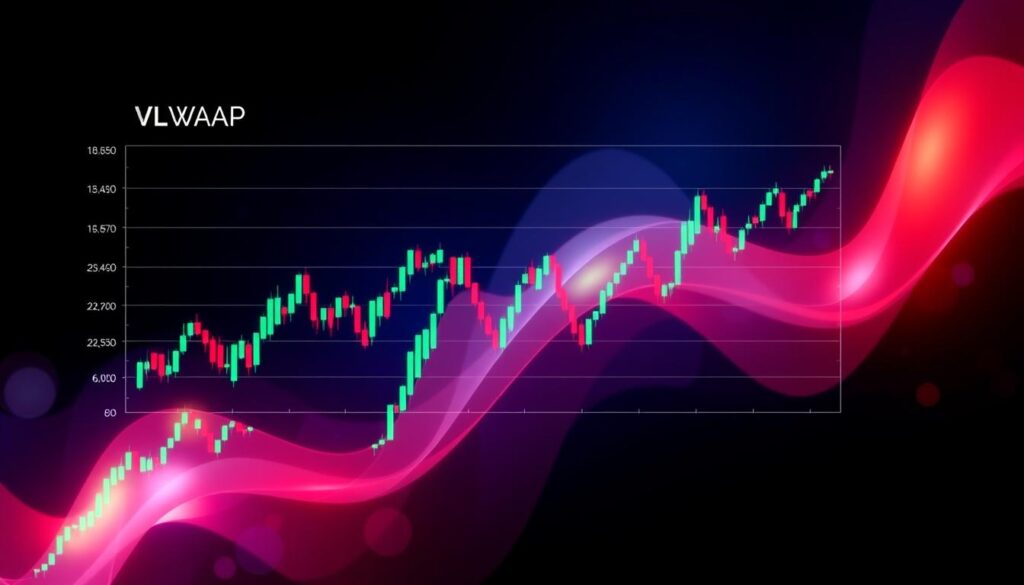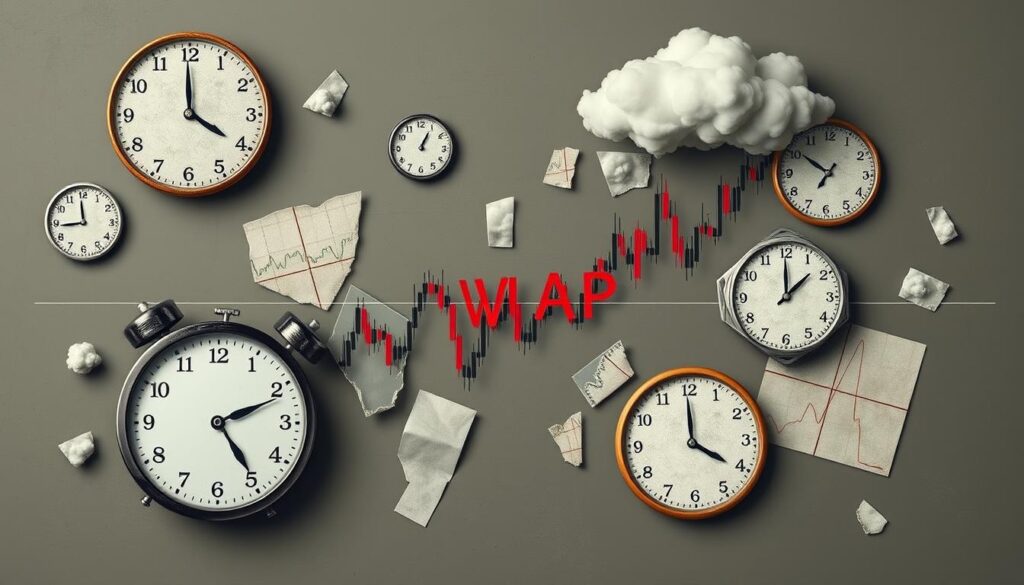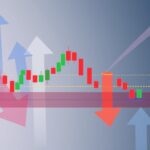The Volume-Weighted Average Price (VWAP) is a technical analysis indicator used on intraday charts that resets at the start of every new trading session. It’s the average price a security has traded at throughout the day, based on both volume and price. This trading indicator is essential for traders, as it provides valuable insights into the level of trading activity during short periods. VWAP is typically most useful to short-term traders for determining intraday price trends on intraday charts.
VWAP incorporates volume data, providing a smoothed-out indication of a security’s price adjusted for volume over time. This helps institutional traders in executing trades without significantly affecting the security’s price. As a lagging indicator, VWAP relies on historical data and does not provide real-time information, but it’s a useful tool for traders seeking to determine the average price of a security based on price and volume during a single trading session, using intraday charts.
Table of Contents
Key Takeaways
- VWAP is a technical analysis indicator used on intraday charts to determine the average price of a security.
- VWAP resets at the start of every new trading session and is based on both volume and price.
- This trading indicator is essential for short-term traders to determine intraday price trends.
- VWAP provides valuable insights into the level of trading activity during short periods on intraday charts.
- VWAP is a lagging indicator that relies on historical data and does not provide real-time information.
- VWAP is a useful tool for traders to determine the average price of a security based on price and volume during a single trading session.
- VWAP can be plotted on thinkorswim charts without using the formula by adding it as a market strength study.
What is Volume-Weighted Average Price (VWAP)?
The Volume-Weighted Average Price, or VWAP, is a trading benchmark that helps investors determine the average price of a security over a specific period. It’s calculated by totaling the dollars traded for every transaction (price multiplied by the volume) and then dividing by the total shares traded. This trading volume and price action data is essential for understanding the VWAP definition.
VWAP is used by many stock traders to determine intraday pricing trends and decide when to buy or sell a security. Institutional investors also use VWAP when making high-volume trades to buy or sell a security close to its VWAP without significantly impacting the stock price. The formula for calculating VWAP is VWAP = Typical price x Volume / Cumulative volume.
Basic Definition and Components
The basic definition of VWAP involves the calculation of the average price of a security based on its trading volume. The components of VWAP include the typical price, volume, and cumulative volume. Understanding these components is crucial for grasping the concept of VWAP and its application in trading.
Historical Development of VWAP
The concept of VWAP has been around for several decades. In 1984, the first execution based on VWAP was conducted for the Ford Motor Company by James Elkins, then head trader at Abel Noser. Since then, VWAP has become a widely used trading benchmark, especially in algorithmic trading.
Why VWAP Matters in Trading
VWAP matters in trading because it provides insights into liquidity and the total value of trades. It’s commonly utilized by traders, pension funds, mutual funds, and market makers as a trading benchmark. A buy order filled below the VWAP is considered a good trade, indicating success in obtaining a favorable price.
| Component | Description |
|---|---|
| Typical Price | The average price of a security over a specific period |
| Volume | The total number of shares traded |
| Cumulative Volume | The total volume of transactions during a trading session |
In conclusion, VWAP is a crucial trading benchmark that helps investors determine the average price of a security over a specific period. Its calculation involves the typical price, volume, and cumulative volume, providing insights into liquidity and the total value of trades.
The Mathematical Formula Behind VWAP
The VWAP calculation is a crucial aspect of understanding the Volume-Weighted Average Price. It involves multiplying the typical price by the volume within a specific time period and then dividing by the total cumulative volume for the day. This formula provides a smoother view of trading trends during the day, assigning more weight to larger trades.
To break it down further, the typical price is calculated as the average of the high, low, and closing prices. This value is then multiplied by the volume and divided by the cumulative volume. The resulting value represents the VWAP, which can be used to gauge stock demand and trends based on volume.
For example, a 17-minute VWAP calculation resulted in a value of $151.24 based on data from a trading session. This value can be used by day traders and institutional investors to make better trading decisions by interpreting VWAP trend lines. To learn more about how VWAP is used in trading, visit this link to understand the rule of 72 and its application in finance.
| Formula | Description |
|---|---|
| VWAP = (Cumulative Typical Price × Volume) / Cumulative Volume | Calculates the Volume-Weighted Average Price |
| Typical Price = (High price + low price + closing price) / 3 | Calculates the average of the high, low, and closing prices |
By understanding the VWAP calculation and its components, traders can make more informed decisions and gain a better understanding of the market trends.
Key Components of VWAP Analysis
VWAP analysis is crucial for understanding market trends and making informed trading decisions. The key components of VWAP analysis include price elements, volume considerations, and time period factors. These components work together to provide a comprehensive view of the market, allowing traders to identify trends and make strategic decisions.
When analyzing VWAP, it’s essential to consider the price action and how it relates to the average price. This involves looking at the high, low, and close prices to determine the overall trend. Additionally, trading volume plays a significant role in VWAP analysis, as it helps to weigh the average price and provide a more accurate representation of the market.
Price Elements
The price elements of VWAP analysis involve looking at the different price points, such as the high, low, and close. This helps to determine the overall trend and identify potential entry and exit points. By analyzing the price action, traders can gain a better understanding of the market and make more informed decisions.
Volume Considerations
Volume considerations are also critical in VWAP analysis. The trading volume helps to weigh the average price, providing a more accurate representation of the market. By analyzing the volume, traders can identify trends and make strategic decisions. For example, a high volume can indicate a strong trend, while a low volume can indicate a weak trend.
Time Period Factors
The time period factors of VWAP analysis involve looking at the different time periods, such as intraday or daily. This helps to determine the overall trend and identify potential entry and exit points. By analyzing the intraday analysis, traders can gain a better understanding of the market and make more informed decisions.
In conclusion, VWAP analysis is a powerful tool for traders, providing a comprehensive view of the market. By considering the key components of VWAP analysis, including price elements, volume considerations, and time period factors, traders can make more informed decisions and identify trends. Whether you’re a seasoned trader or just starting out, VWAP analysis is an essential tool to have in your arsenal.
How VWAP Differs from Other Trading Indicators
When it comes to technical indicators, traders have a wide range of options to choose from, including moving averages. However, the volume-weighted average price (VWAP) stands out from the crowd due to its unique calculation method, which takes into account both price and volume. In a VWAP comparison with other indicators, it becomes clear that VWAP is particularly useful for identifying trends and making informed trading decisions.
A key difference between VWAP and other technical indicators, such as simple moving averages, is the way it incorporates volume into its calculation. This makes VWAP a more accurate representation of market activity, as it gives more weight to periods of high trading volume. For example, a stock may be trading at a high price, but if the volume is low, the VWAP will not be significantly affected. On the other hand, if the stock is trading at a high price with high volume, the VWAP will be pulled upwards, indicating a stronger trend.
In contrast to other indicators, such as exponential moving averages, VWAP is not sensitive to price fluctuations and is better suited for mean reversion strategies. The choice between VWAP and other indicators, such as volume-weighted moving averages (VWMA), depends on the trader’s strategy and preferences. While VWMA is more sensitive to price fluctuations and changes in trading volume, making it better for determining trends quickly, VWAP is more effective for intraday trading and identifying short-term deviations from the average.
Some key benefits of using VWAP include:
- More accurate representation of market activity
- Better suited for mean reversion strategies
- Effective for intraday trading and identifying short-term deviations from the average
By understanding how VWAP differs from other trading indicators, traders can make more informed decisions and choose the best tools for their strategy. Whether using moving averages, technical indicators, or a combination of both, VWAP is a valuable tool for any trader looking to gain an edge in the market.
Benefits of Using VWAP in Trading Decisions
When it comes to developing a trading strategy, understanding market analysis and price trends is crucial. The Volume-Weighted Average Price (VWAP) is a valuable tool that provides insights into both the price trend and value of a security. By incorporating VWAP into their trading strategy, traders can make more informed decisions and improve their market analysis.
VWAP aids in price discovery, helping traders identify fair value and potential entry or exit points. It also provides volume analysis benefits, giving insights into trading activity and liquidity. Additionally, VWAP can reveal market timing opportunities, such as potential trend reversals or continuations. Some of the key benefits of using VWAP include:
- Assessing whether a stock is undervalued or overvalued based on its position relative to the VWAP
- Determining trends and identifying potential entry or exit points
- Reducing market impact costs by executing large orders without significantly affecting market prices
By using VWAP in conjunction with other technical indicators, traders can enhance their market analysis and make more accurate predictions about price trends. For example, pairing VWAP with Moving Averages or the Stochastic oscillator can provide a more comprehensive understanding of market trends. Overall, VWAP is a powerful tool that can help traders develop a successful trading strategy and improve their market analysis.
Some traders also use VWAP to anticipate where their order will likely be filled by analyzing its distance relative to the current VWAP. Orders closer to VWAP are more likely to be filled, making it a useful tool for traders looking to execute trades at fair prices. By incorporating VWAP into their trading strategy, traders can gain a competitive edge and make more informed decisions about their trades.
| Benefits of VWAP | Description |
|---|---|
| Price Discovery | Helps traders identify fair value and potential entry or exit points |
| Volume Analysis | Provides insights into trading activity and liquidity |
| Market Timing | Reveals potential trend reversals or continuations |
Common VWAP Trading Strategies
Traders often use Volume-Weighted Average Price (VWAP) as a trend confirmation tool and build trading rules around it. For instance, they may consider stocks with prices below VWAP as undervalued and those with prices above it as overvalued. Two popular approaches include VWAP crossovers and mean reversion strategies.
VWAP crossovers involve looking for price movements above or below the VWAP line as potential entry or exit signals. This strategy can be used in conjunction with trend following techniques to maximize profits. Mean reversion strategies, on the other hand, involve trading on the assumption that prices will return to the VWAP over time.
- Buying when the closing price is above VWAP
- Selling when the closing price is below VWAP
- Using VWAP as a support or resistance level
These strategies can be used by both novice and experienced traders to make informed trading decisions.
VWAP and Market Microstructure
Institutional trading plays a significant role in market dynamics, and Volume-Weighted Average Price (VWAP) is a crucial indicator in this context. Institutional buyers, including mutual funds, use VWAP to minimize market impact when executing large orders. By buying below the VWAP or selling above it, institutions can reduce the potential price effects of their trades.
The relationship between VWAP and market microstructure is complex, involving various trading algorithms and strategies. Institutional trading patterns are influenced by VWAP, as institutions aim to achieve an average execution price close to the VWAP. This is particularly important for large trades, which can significantly impact market prices.
Institutional Trading Patterns
Market impact analysis is a critical aspect of VWAP trading, as it helps institutions gauge the potential price effects of their trades. By analyzing market dynamics and trading algorithms, institutions can develop strategies to minimize market impact and achieve better execution prices.
Market Impact Analysis
Liquidity considerations are also essential in VWAP trading, as they can affect the execution price and market impact of trades. By analyzing liquidity and market depth, institutions can develop strategies to optimize their trades and achieve better execution prices. The following table summarizes the key aspects of VWAP and market microstructure:
| Aspect | Description |
|---|---|
| VWAP | Volume-Weighted Average Price, used to minimize market impact |
| Institutional Trading Patterns | Influenced by VWAP, aim to achieve average execution price close to VWAP |
| Market Impact Analysis | Helps institutions gauge potential price effects of trades, develop strategies to minimize market impact |
| Liquidity Considerations | Affect execution price and market impact, institutions analyze liquidity and market depth to optimize trades |
By understanding the relationship between VWAP and market microstructure, institutions can develop effective trading strategies that minimize market impact and achieve better execution prices. This requires a deep analysis of market dynamics, trading algorithms, and liquidity considerations.
Real-World Applications of VWAP
VWAP gives traders a smoothed-out indication of a security’s price adjusted for volume, over time. In day trading, VWAP is used to determine trend changes quicker than moving averages. Traders can use VWAP to identify whether a stock is cheap or expensive on a given day, assisting in intelligent entry and exit points for day trades.
In algorithmic trading, VWAP is incorporated into strategies to ensure that trades do not move the price of the security being traded too extremely. This is particularly important for institutional traders who need to execute large orders without significantly impacting the market price. Portfolio management also benefits from VWAP, as it helps managers to achieve best execution of trades and minimize market impact.
Some key applications of VWAP include:
- Breakout trading setups, where the price drops below the VWAP
- Pullback setups, where the price returns to the VWAP level on the chart
- Identifying trend changes and continuations
- Determining optimal entry and exit points for trades
VWAP is a powerful tool that can be used in various trading scenarios, from day trading to portfolio management. By understanding how to apply VWAP in real-world situations, traders can gain a competitive edge in the markets and make more informed trading decisions.
| Trading Scenario | VWAP Application |
|---|---|
| Day Trading | Identifying trend changes and optimal entry/exit points |
| Algorithmic Trading | Minimizing market impact and ensuring best execution of trades |
| Portfolio Management | Achieving best execution of large orders and minimizing market impact |
Limitations and Potential Drawbacks of VWAP
While VWAP is a valuable tool for traders, it’s essential to understand its limitations. One of the primary VWAP limitations is that it’s a single-day indicator, which means it restarts at the opening of each new trading day. Attempting to create an average VWAP over many days could distort it and result in an incorrect indicator. This can lead to trading risks, especially in markets with high market volatility.
Some of the key limitations of VWAP include:
- Lagging nature: VWAP is based on historical data, which can make it less effective in rapidly changing markets.
- Less effective in low liquidity markets: VWAP can be influenced by large traders, which can affect its accuracy in markets with low liquidity.
- Susceptible to manipulation: VWAP can be manipulated by large traders, which can impact its reliability.
Despite these limitations, VWAP can still be a useful tool for traders when used in conjunction with other indicators and strategies. By understanding the VWAP limitations and potential drawbacks, traders can use it more effectively to minimize trading risks and make more informed decisions in market volatility.
| VWAP Limitations | Description |
|---|---|
| Lagging nature | VWAP is based on historical data, making it less effective in rapidly changing markets. |
| Less effective in low liquidity markets | VWAP can be influenced by large traders, affecting its accuracy in markets with low liquidity. |
| Susceptible to manipulation | VWAP can be manipulated by large traders, impacting its reliability. |
VWAP in Different Market Conditions
Understanding how VWAP behaves in various market conditions is crucial for making informed trading decisions. In bullish markets, prices tend to stay above the VWAP line, indicating an upward trend. During such periods, traders can use VWAP to identify potential entry points and ride the trend.
In contrast, bearish trends are characterized by prices remaining below the VWAP line. In these conditions, traders may use VWAP to determine when to exit or short a position. Sideways markets present a unique challenge, as prices may fluctuate around the VWAP line. Here, traders can use VWAP to identify potential breakouts or reversals.
Some key considerations for using VWAP in different market conditions include:
- Adjusting trading strategies based on market volatility
- Using VWAP to identify support and resistance levels
- Combining VWAP with other technical indicators for more accurate analysis
By understanding how VWAP performs in bullish markets, bearish trends, and sideways markets, traders can refine their strategies and make more informed decisions. Whether used as a standalone indicator or in combination with other tools, VWAP is a powerful resource for navigating various market conditions.
Combining VWAP with Other Technical Indicators
When it comes to technical analysis, combining different indicators can provide a more comprehensive view of the market. The Volume-Weighted Average Price (VWAP) is no exception. By combining VWAP with other technical indicators, traders can create more robust trading strategies and generate accurate trading signals.
One way to combine VWAP with other indicators is to use it in conjunction with moving averages. This can help traders identify trends and potential reversals. For example, if the price is above the VWAP and the moving average is also rising, it could be a bullish signal. On the other hand, if the price is below the VWAP and the moving average is falling, it could be a bearish signal.
Another way to combine VWAP with other indicators is to use it with the Relative Strength Index (RSI). The RSI is a momentum indicator that measures the magnitude of recent price changes. By combining VWAP with RSI, traders can identify overbought or oversold conditions in the market. For example, if the price is above the VWAP and the RSI is above 70, it could be a sign of overbought conditions. On the other hand, if the price is below the VWAP and the RSI is below 30, it could be a sign of oversold conditions.
Here are some benefits of combining VWAP with other technical indicators:
- Improved accuracy of trading signals
- Increased confidence in trading decisions
- Enhanced risk management
By combining VWAP with other technical indicators, traders can create a more comprehensive trading strategy that takes into account multiple market factors. This can help traders make more informed decisions and improve their overall trading performance.
| Indicator | Description |
|---|---|
| VWAP | Volume-Weighted Average Price |
| RSI | Relative Strength Index |
| Moving Averages | Used to identify trends and potential reversals |
Best Practices for VWAP Implementation
When it comes to implementing VWAP in trading strategies, several best practices can help traders maximize their potential. Risk management is crucial, as it enables traders to set appropriate stop-loss and take-profit levels based on VWAP. This involves understanding the context of VWAP signals and incorporating them into a broader trading plan.
Traders should consider the following VWAP trading tips:
- Use VWAP in conjunction with other forms of analysis to confirm trading decisions
- Set realistic expectations and avoid over-reliance on a single indicator
- Stay disciplined and manage emotions when using VWAP
Effective trading psychology is also essential, as it helps traders maintain a clear mindset and make informed decisions. By combining VWAP with other technical indicators, such as Moving Averages and Relative Strength Index (RSI), traders can enhance their analysis and make more accurate predictions. Ultimately, the key to successful VWAP implementation is to strike a balance between technical analysis and risk management, ensuring that traders can navigate the markets with confidence and precision.
Conclusion: Mastering VWAP for Trading Success
As we’ve explored, VWAP (Volume-Weighted Average Price) is a powerful tool in the trader’s arsenal. While it provides valuable insights on its own, the true mastery comes from integrating VWAP into a comprehensive trading strategy. By continuously learning and refining your approach, you can leverage VWAP to make informed decisions and maximize your trading success.
Remember, VWAP trading is not a one-size-fits-all solution. It works best when combined with other technical indicators, such as moving averages and volume analysis. By diversifying your trading toolkit, you’ll be better equipped to navigate the ever-changing market conditions and identify profitable opportunities.
The key to VWAP mastery lies in continuous education and practice. Stay up-to-date with the latest market trends and industry insights, and don’t be afraid to experiment with different trading strategies. The more you immerse yourself in the world of VWAP, the more intuitive it will become, and the more confident you’ll be in your trading decisions.
As you embark on your VWAP trading journey, remember to stay patient, disciplined, and focused on your long-term goals. With dedication and a willingness to learn, you’ll be well on your way to achieving trading success. Happy trading!
FAQ
What is Volume-Weighted Average Price (VWAP)?
VWAP is a trading indicator that represents the average price of a security, weighted by the trading volume. It is used to analyze price movements and trading activity throughout the trading day.
Why is VWAP important for traders?
VWAP is an essential tool for both retail and institutional traders as it provides insights into price discovery, liquidity, and market timing opportunities, helping them make more informed trading decisions.
How is the VWAP formula calculated?
The VWAP formula is calculated by summing the product of each trade’s price and volume, and then dividing that sum by the total trading volume over a specific time period.
What are the key components that influence VWAP?
The three main components that influence VWAP are price, volume, and time. VWAP takes into account the price, the trading volume at each price point, and the time period over which it is calculated.
How does VWAP differ from other trading indicators like moving averages?
VWAP is unique in that it is volume-weighted, whereas indicators like Simple Moving Averages (SMA) and Exponential Moving Averages (EMA) are not. This volume-weighting gives VWAP the ability to provide more accurate insights into market activity and fair value.
What are the main benefits of using VWAP in trading strategies?
The key benefits of using VWAP include improved price discovery, enhanced volume analysis, and better market timing opportunities, all of which can help traders make more informed trading decisions.
What are some common VWAP trading strategies?
Popular VWAP trading strategies include VWAP crossovers, mean reversion strategies, and trend-following approaches, each with their own unique characteristics and applications.
How do institutional traders use VWAP?
Institutional traders often use VWAP to minimize market impact when executing large orders, as well as to analyze liquidity and market microstructure dynamics.
What are the potential limitations and drawbacks of relying on VWAP?
Some limitations of VWAP include its technical limitations (such as the daily reset), its effectiveness in different market conditions, and the challenges in implementing it for longer time frames.
How can VWAP be used in conjunction with other technical indicators?
VWAP can be combined with other technical indicators, such as moving averages, momentum indicators, and volume profile analysis, to create more robust and comprehensive trading strategies.









